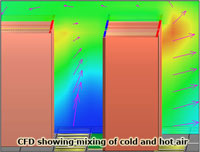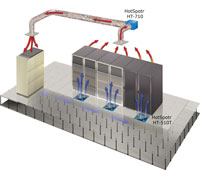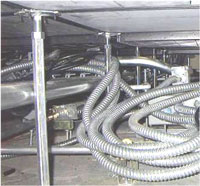We have all heard many statistics in recent years about how much money is being spent on powering data center servers and the infrastructure supporting them. Keeping up with demands from power and cooling technology and equipment is tough.
In most legacy data centers, cooling designs utilize Computer Room Air Condintioning (CRAC) units along the perimeter of the room and perforated tiles in the raised floor – these designs are not capable of cooling higher density cabinet loads. These legacy data centers often suffer from one or more of the following problems:
- Sub-floor supply-air plenums are clogged with cabling
- Hot aisles are misaligned with the CRAC unit return-air inlets
- High-density racks are isolated from adequate supply air and return air paths
- Overcooling
These issues can cause hot spots and result in cooling system inefficiencies. There are many opportunities to reclaim capacity and reduce electrical costs in your data center – here are just a few that we recommend:
Prevent Hot & Cold Air Mixing - When hot exhaust air mixes with cold air, i t increases the intake temperature at your equipment. This means that you may have to set the temperature even lower so that you can deliver an acceptable intake temperature to your gear. By isolating the exhaust air with a hot aisle containment system or ceiling returns, you can reduce the load on your cooling system and increase the power density of your racks.
t increases the intake temperature at your equipment. This means that you may have to set the temperature even lower so that you can deliver an acceptable intake temperature to your gear. By isolating the exhaust air with a hot aisle containment system or ceiling returns, you can reduce the load on your cooling system and increase the power density of your racks.
For rooms with raised floors, installing thermostatically controlled air movers (such as HotSpotr underfloor and overhead air movers) in the floor and return air systems that utilize the space above drop ceilings for warm air to return to the CRAC units can help to significantly improve the overall efficiency of the cooling system. These types of installations are relatively inexpensive compared with new infrastructure and facility upgrades.
underfloor and overhead air movers) in the floor and return air systems that utilize the space above drop ceilings for warm air to return to the CRAC units can help to significantly improve the overall efficiency of the cooling system. These types of installations are relatively inexpensive compared with new infrastructure and facility upgrades.
Prevent Overcooling - Keep in mind that added IT load does not always mean more cooling units are needed – often there is more than enough capacity in place but it’s not being utilized effectively. Without the proper systems in place to address high density loads, Data Center managers have no choice but to over-cool the data center in an attempt to address hot spots. A data center audit, CFD study and the resulting recommendations can increase cooling system effectiveness and reduce energy consumption.
Manage Air Flow – It is important to remove unused cabling and other under-floor obstructions from under the raised floor.  Designated cable pathways and wire management solutions can help to limit congestion and abandoned cables should be routinely removed from the plenum. Plug any cable cutouts in the floor to prevent cold air from leaking and add blanking panels into all open slots in the IT racks to prevent hot air circulating to the server inlets. These small changes will improve airflow and efficiency of the cold air delivery systems.
Designated cable pathways and wire management solutions can help to limit congestion and abandoned cables should be routinely removed from the plenum. Plug any cable cutouts in the floor to prevent cold air from leaking and add blanking panels into all open slots in the IT racks to prevent hot air circulating to the server inlets. These small changes will improve airflow and efficiency of the cold air delivery systems.
Today’s data center owners are directing their technology and facility management teams to reduce energy consumption – by using these few opportunities to reduce energy, existing data center operators can be leaders in this effort.
Let us know if you have implemented any of these items and how they have worked in saving energy. Need more information – feel free to contact us.

